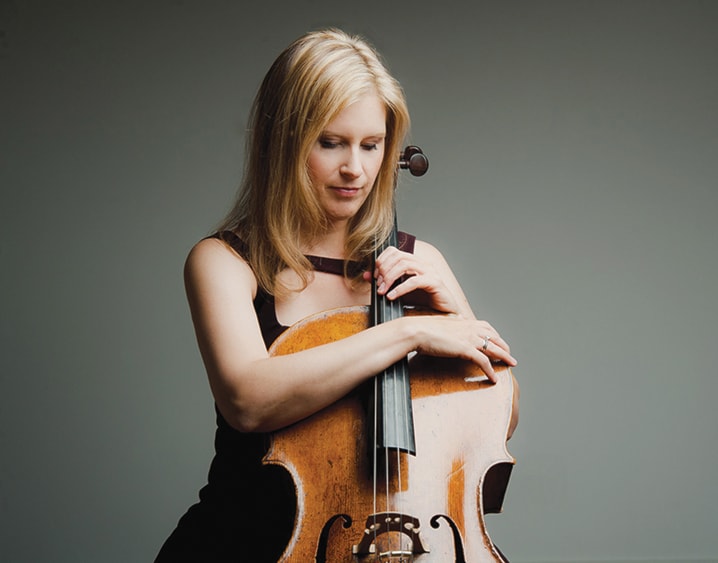The Red Deer Symphony Orchestra will starts its new season with three memorable works that look back at the past in grandiose, anxious and whimsical ways.
Compositions by Wolfgang Amadeus Mozart, Dmitri Shostakovich and Benjamin Britten are on the program for the Continental Cello concert on Saturday, Oct. 4, at the Red Deer College Arts Centre.
The weightiest work is Shostakovich’s extraordinary Cello Concerto No. 1, which will feature Toronto soloist Winona Zelenka on cello and the full orchestra (minus most of its brass section).
RDSO music director Claude Lapalme calls this piece, which requires an orchestra with only one horn to compliment the solo cello, “the soul of the concert.” It’s also his favourite of all Shostakovich concertos.
To understand why the work is so special, he believes listeners need to understand the turbulent times in which it was written. The Russian composer, who lived in the first seven decades of the last century, spent various periods being either in or out of favour with the Soviet Union’s ruling Communist Party.
Whenever Shostakovich fell into disfavour, he dreaded that the secret police would show up in the middle of the night to declare him an “enemy of the state” and haul him off to jail. Many people who were taken into custody were never heard from again.
The composer was so certain this could happen that he kept a packed suitcase under his bed, said Lapalme, in case his number came up.
It never did. Although the composer was often criticized by authorities for his “coarse, primitive and vulgar” works, Shostakovich managed to make it to almost 70 before dying — of lung cancer, as it turned out.
But many of his friends were not as fortunate, and something of the anxiety he and others suffered during the Joseph Stalin years made its way into his music.
His Cello Concerto No. 1, from 1959, inspired the melody for Shostakovich’s later String Quartet No. 8, which looks back at his life as a study of apprehension. The concerto is as tense as a Franz Kafka novel.
Lapalme said the first movement is like a chase scene, “an extraordinary description of there being nowhere to hide.”
The second slower movement evokes “desperate loneliness,” while the third movement for cello alone, appears to be the composer’s despairing rumination on the human condition. Lapalme said the final movement rounds to a chase again — which might create the same impression as a snake swallowing its tail.
Shostakovich’s own political views couldn’t be expressed during his lifetime, so he remains something of an enigma. Lapalme suggested listeners might well wonder how much of a communist he really was.
Like other artists, Shostakovich sought to tell the truth through his art. “You take a chance and be truthful and hope it will be OK,” added the music director, who got an unexpected reaction when he spoke of the concerto story with another musician.
This cello player from Edmonton told Lapalme she would have trouble playing the piece in future, since her father was one of the people who was hauled out of bed in the middle of the night by the police during her childhood in Poland. He spent six years in jail.
To counterbalance the heavy Shostakovich work, two lighter compositions will also be played by the RDSO.
Mozart’s Symphony No. 31 is a grand, majestic piece written to impress the Parisians. Lapalme said the Austrian composer first played in Paris when he was a callow — albeit highly gifted — child prodigy.
Upon returning to the city as a more established composer in his 20s, Mozart was looking back at his first appearance in the French capital and vowing to really wow the Parisians with his more seasoned skills.
“It’s a very fun, energetic work.”
Britten was also looking back at his childhood when he wrote his Simple Symphony. The British composer gathered all the short, juvenilia he had composed as a 10- or 11-year-old and wove it into this larger work — which shows Britten always had a great gift for creating ear-catching tunes, said Lapalme. “It’s a tribute to youth.”
Britten also revealed his whimsical side with the alliterative titles he gave the symphony’s four movements: Boisterous Bourrée, Sentimental Serabande, Playful Pizzicato and Frolicsome Finale.
Lapalme believes the audience will enjoy this emotion-packed first concert, which should provide a stirring start to the RDSO season.
Tickets for the 8 p.m. concert are $59.35 ($54.85 seniors/$43.35 students or first four rows) from the Black Knight Ticket Centre.
lmichelin@www.reddeeradvocate.com
